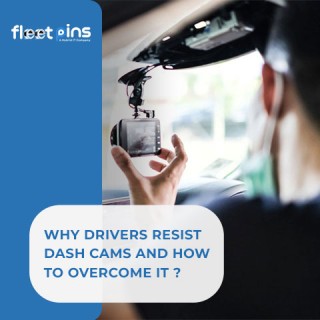- On 2025-03-19
Impact of GPS Tracking on Logistics and Supply Chain
Have you ever ordered something online and tracked your package as it made its way to you? That is GPS tracking in action! GPS has completely changed the way companies move and deliver goods. With GPS Trackers, businesses can optimize routes, reduce costs, and ensure timely deliveries with real-time tracking. It helps businesses track shipments in real-time, improve delivery efficiency, save money, and increase safety. But, like any technology, GPS tracking comes with some challenges, too.
At Fleet Pins, we’ll explore how GPS technology in the supply chain works. Let’s also explore real-time tracking for logistics and the challenges companies face when using it.
What Are the Benefits of GPS Tracking in Logistics?
GPS tracking plays a major role in modern logistics. It helps companies know exactly where their vehicles, drivers, and shipments are at all times. Let’s take a closer look at some of its key benefits.
Real-Time Shipment Tracking
One of the biggest advantages of GPS tracking is real-time tracking. This means companies can see exactly where a truck or package is at any moment. This is helpful in many ways:
-
Customers get updates on their deliveries, reducing uncertainty.
-
Companies can quickly solve delays by rerouting shipments if needed.
-
It helps reduce theft, as stolen goods can be traced instantly.
For example, if a truck carrying important medical supplies is delayed, the company can take immediate action to find a faster route.
Improved Efficiency and Faster Deliveries
GPS tracking makes deliveries faster and smoother. It helps companies find the best routes for their drivers by avoiding traffic jams and roadblocks. This helps in supply chain visibility. This leads to:
-
Less fuel consumption—Using shorter or less crowded routes saves fuel.
-
Faster deliveries—Customers receive their packages sooner.
-
Better time management—Drivers don’t waste time on inefficient routes.
For businesses that rely on quick deliveries, such as food suppliers or e-commerce companies, GPS tracking is a game-changer.
Increased Safety and Security
GPS tracking also plays an important role in keeping drivers, shipments, and vehicles safe. Here’s how:
-
Companies can monitor their drivers’ speed and behavior to prevent accidents.
-
If a vehicle is stolen, GPS tracking helps authorities locate it quickly.
-
Dangerous areas can be avoided by planning safer routes.
By ensuring that vehicles follow the right paths and drivers follow safety rules, businesses can prevent losses and ensure the well-being of their employees. To further enhance driver safety, explore The Role of AI Dash Cams in Alerting Drowsy Drivers, which explains how AI technology can detect and prevent fatigue-related incidents.
Cost Savings
GPS tracking helps businesses save money in several ways:
-
Optimized routes reduce unnecessary driving.
-
Monitoring vehicles helps detect maintenance issues early.
-
Tracking shipments helps prevent theft.
By cutting costs, businesses can invest in other areas, such as improving logistics efficiency, supply chain visibility, or expanding their reach.
Challenges of Implementing GPS Tracking
Even though GPS tracking is highly beneficial, companies face some difficulties when trying to use it. Let’s take a look at these challenges and how they can be tackled.
High Initial Costs
One of the biggest hurdles for companies is the cost of setting up GPS tracking in logistics. For small businesses, these costs can be a burden. However, companies can start with basic tracking systems and upgrade as they grow.
Businesses need to invest in:
-
GPS tracking devices for their vehicles
-
Software to monitor and analyze data
-
Employee training to use the technology effectively
Managing and Integrating Data
GPS systems collect huge amounts of data. Managing this data effectively can be challenging because
-
Companies need to analyze real-time information quickly.
-
The data must be integrated with other business systems, like inventory and billing software.
-
Proper security measures must be in place to protect sensitive information.
To solve this, companies can use advanced software solutions that simplify data management and provide useful insights. For tips on maintaining your fleet’s dash cams, visit Essential Dash Cam Maintenance Tips for Optimal Performance, which ensures your devices operate smoothly and securely.
Employee Resistance and Training
Some employees, especially drivers, may not feel comfortable with GPS tracking. They might worry about:
-
Privacy concerns (feeling like they’re being watched all the time).
-
Learning to use new technology.
-
Increased pressure to perform efficiently.
The best way to handle this challenge is through proper communication and training. Companies should explain that GPS tracking is meant to improve safety and efficiency, not to spy on workers. Providing training to employees and showing them how GPS benefits them can also help reduce resistance.
How Companies Can Overcome GPS Tracking Challenges
Even though there are challenges, companies can take simple steps to successfully implement GPS tracking. Here, we can see how to implement logistics and supply chain operations.
Conduct a Cost-Benefit Analysis
By comparing costs with long-term benefits, companies can make smart financial decisions. Before investing in GPS tracking, businesses should analyze:
-
How much they will spend on the system
-
How much money they will save over time
-
How GPS tracking will improve efficiency
-
How GPS tracking will improve customer satisfaction
Choose the Right GPS Tracking Provider
Not all GPS tracking solutions are the same. Businesses should
-
Look for providers with good reviews and reliable customer support.
-
Choose software that integrates well with their existing systems.
-
Select vehicles as per specific needs, whether it’s tracking vehicles, shipments, or inventory.
A trusted provider can help businesses set up GPS tracking smoothly and ensure that the system works efficiently.
Provide Employee Training and Support
Employees need to feel comfortable using GPS tracking. Businesses should
-
Organize training sessions to teach workers how to use the system.
-
Address any privacy concerns by explaining the purpose of tracking.
-
Encourage employees by showing them how GPS makes their jobs easier and safer.
Clear communication and proper training can make the transition much smoother.
To ensure your drivers are fully supported, check out How Fleet Dash Cams Reduce Driver Distractions, which offers tips on improving driver focus and compliance.
The Future of GPS Tracking in Logistics
The future of GPS tracking looks exciting, with more advanced features being developed. Some upcoming trends include:
Artificial Intelligence (AI) Integration
AI will help analyze GPS data to predict traffic and suggest better routes.
Better Connectivity
With 5G networks, GPS tracking will become even faster and more accurate.
Eco-Friendly Solutions
Companies will use GPS tracking to reduce carbon footprints by optimizing fuel usage and cutting down emissions.
As technology improves, GPS tracking will continue to play a major role in making logistics and supply chains more efficient and reliable.
Conclusion
GPS tracking has completely transformed the logistics and supply chain industry. From tracking shipments in real-time to improving efficiency and security, logistics businesses must overcome challenges. By training employees properly, companies can make the most out of GPS tracking.
As technology evolves, GPS tracking will become even more advanced, helping businesses deliver goods faster, safer, and more efficiently than ever before. With Fleet Pins, GPS tracking unit providers can make their logistics efficient. So, consult now to improve your supply chain management.
Ready to see how GPS tracking and dash cams can transform your fleet operations? Book a demo today and discover the tools to streamline your logistics and enhance safety.




